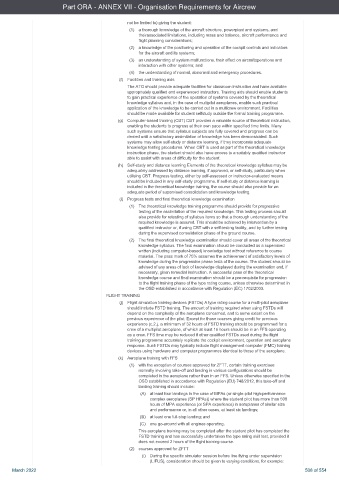Page 508 - UK AirCrew Regulations (Consolidated) March 2022
P. 508
Part ORA - ANNEX VII - Organisation Requirements for Aircrew
not be limited to) giving the student:
(1) a thorough knowledge of the aircraft structure, powerplant and systems, and
theirassociated limitations, including mass and balance, aircraft performance and
flight planning considerations;
(2) a knowledge of the positioning and operation of the cockpit controls and indicators
for the aircraft and its systems;
(3) an understanding of system malfunctions, their effect on aircraftoperations and
interaction with other systems; and
(4) the understanding of normal, abnormal and emergency procedures.
(f) Facilities and training aids
The ATO should provide adequate facilities for classroom instruction and have available
appropriately qualified and experienced instructors. Training aids should enable students
to gain practical experience of the operation of systems covered by the theoretical
knowledge syllabus and, in the case of multipilot aeroplanes, enable such practical
application of the knowledge to be carried out in a multicrew environment. Facilities
should be made available for student selfstudy outside the formal training programme.
(g) Computer-based training (CBT) CBT provides a valuable source of theoretical instruction,
enabling the students to progress at their own pace within specified time limits. Many
such systems ensure that syllabus subjects are fully covered and progress can be
denied until a satisfactory assimilation of knowledge has been demonstrated. Such
systems may allow self-study or distance learning, if they incorporate adequate
knowledge testing procedures. When CBT is used as part of the theoretical knowledge
instruction phase, the student should also have access to a suitably qualified instructor
able to assist with areas of difficulty for the student.
(h) Self-study and distance learning Elements of the theoretical knowledge syllabus may be
adequately addressed by distance learning, if approved, or self-study, particularly when
utilising CBT. Progress testing, either by self-assessed or instructor-evaluated means
should be included in any self-study programme. If self-study or distance learning is
should be included in any self-study programme. If self-study or distance learning is
included in the theoretical knowledge training, the course should also provide for an
adequate period of supervised consolidation and knowledge testing.
(i) Progress tests and final theoretical knowledge examination
(1) The theoretical knowledge training programme should provide for progressive
testing of the assimilation of the required knowledge. This testing process should
also provide for retesting of syllabus items so that a thorough understanding of the
required knowledge is assured. This should be achieved by intervention by a
qualified instructor or, if using CBT with a self-testing facility, and by further testing
during the supervised consolidation phase of the ground course.
(2) The final theoretical knowledge examination should cover all areas of the theoretical
knowledge syllabus. The final examination should be conducted as a supervised
written (including computer-based) knowledge test without reference to course
material. The pass mark of 75% assumes the achievement of satisfactory levels of
knowledge during the progressive phase tests of the course. The student should be
advised of any areas of lack of knowledge displayed during the examination and, if
necessary, given remedial instruction. A successful pass of the theoretical
knowledge course and final examination should be a pre-requisite for progression
to the flight training phase of the type rating course, unless otherwise determined in
the OSD established in accordance with Regulation (EC) 1702/2003.
FLIGHT TRAINING
(j) Flight simulation training devices (FSTDs) A type rating course for a multi-pilot aeroplane
should include FSTD training. The amount of training required when using FSTDs will
depend on the complexity of the aeroplane concerned, and to some extent on the
previous experience of the pilot. Except for those courses giving credit for previous
experience (c.2.), a minimum of 32 hours of FSTD training should be programmed for a
crew of a multipilot aeroplane, of which at least 16 hours should be in an FFS operating
as a crew. FFS time may be reduced if other qualified FSTDs used during the flight
training programme accurately replicate the cockpit environment, operation and aeroplane
response. Such FSTDs may typically include flight management computer (FMC) training
devices using hardware and computer programmes identical to those of the aeroplane.
(k) Aeroplane training with FFS
(1) with the exception of courses approved for ZFTT, certain training exercises
normally involving take-off and landing in various configurations should be
completed in the aeroplane rather than in an FFS. Unless otherwise specified in the
OSD established in accordance with Regulation (EU) 748/2012, this take-off and
landing training should include:
(A) at least four landings in the case of MPAs (or single-pilot high-performance
complex aeroplanes (SP HPAs)) where the student pilot has more than 500
hours of MPA experience (or SPA experience) in aeroplanes of similar size
and performance or, in all other cases, at least six landings;
(B) at least one full-stop landing; and
(C) one go-around with all engines operating.
This aeroplane training may be completed after the student pilot has completed the
FSTD training and has successfully undertaken the type rating skill test, provided it
does not exceed 2 hours of the flight training course.
(2) courses approved for ZFTT
(i) During the specific simulator session before line flying under supervision
(LIFUS), consideration should be given to varying conditions, for example:
March 2022 508 of 554

